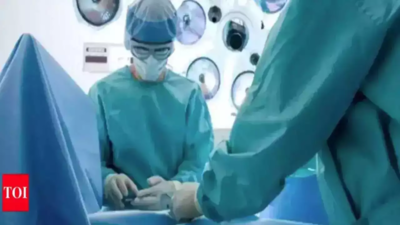- News
- City News
- faridabad News
- Delhi man’s ear bitten off by pit bull, reattached post 11-hr surgery
Trending
Delhi man’s ear bitten off by pit bull, reattached post 11-hr surgery
A 22-year-old's left ear was successfully reattached after his pet dog bit it off, thanks to an 11-hour microsurgery by doctors at Amrita Hospital, Faridabad. The surgery, which included intricate revascularisation, restored his ear and confidence. The patient is now recovering well.

Representative Image
The intricate microsurgical replantation took 11 hours to complete. "The complex surgical procedure not only restored the young man's physical appearance but also helped him regain his confidence," said doctors who performed the surgery at Amrita Hospital, Faridabad.

According to doctors, the patient, who is from Faridabad, was immediately taken to the emergency room, where the hospital's medical team prioritised re-establishing blood flow to the ear.
Explaining the challenges faced during the surgery, Dr Mohit Sharma, head of plastic and reconstructive surgery, said, "The vessels of the ear are extremely small, measuring less than 0.5mm. This, combined with the fact that the vessels were torn and not clean cut, made the surgery especially challenging. The damaged section of the artery and vein had to be replaced with a small segment of vein from another part of the body to bridge the gap and revascularise the ear."
He added that the surgery, which took place on May 12, required the use of a 40X magnification operating microscope and super-microsurgical instruments to reconnect the tiny vessels.
The team completed two surgeries over 11 hours, with the first operation lasting six hours and the second five hours. The patient's condition also required immediate attention to prevent infection, and the medical team administered anti-rabies immunoglobulin and intravenous antibiotics.
Dr Devajyoti Guin, senior consultant and assistant professor of plastic and reconstructive surgery, said the most difficult part of the surgery was joining the artery and vein in such tiny vessels. "The initial branch we connected wasn't supplying enough blood, so we had to perform the arterial anastomosis again on a better branch," he pointed out.
Even after revascularisation, the ear needed constant attention to ensure that the vein was draining adequately and the team had to regularly manage the ear with heparin drips to prevent complications, Dr Guin added.
Following the operation, the patient remained in the hospital for eight days. Upon discharge, it was observed that the patient's ear had successfully undergone complete revascularisation and remained viable.
The patient expressed his gratitude, saying, "Getting my ear back feels like getting a part of myself back. I was terrified that I would be disfigured for life, but the doctors at Amrita Hospital made sure that didn't happen. I am so grateful for the care and expertise they provided." The patient is expected to be able to lead a normal life.
End of Article
FOLLOW US ON SOCIAL MEDIA








